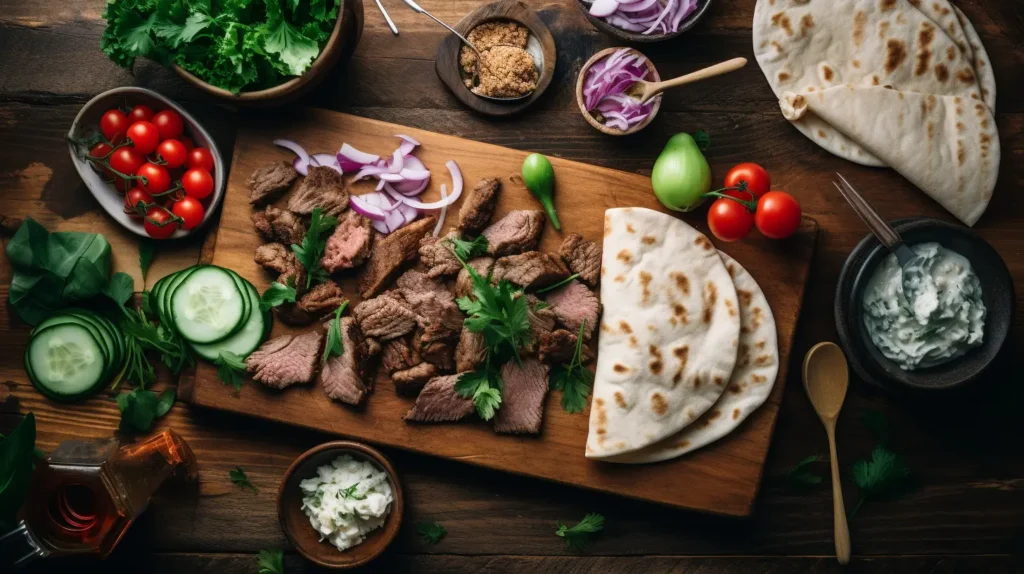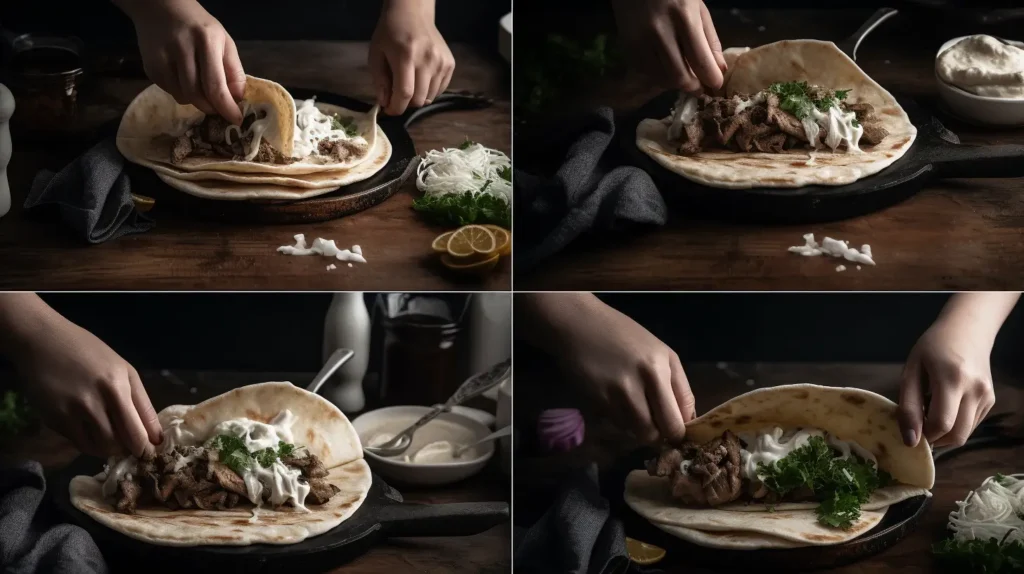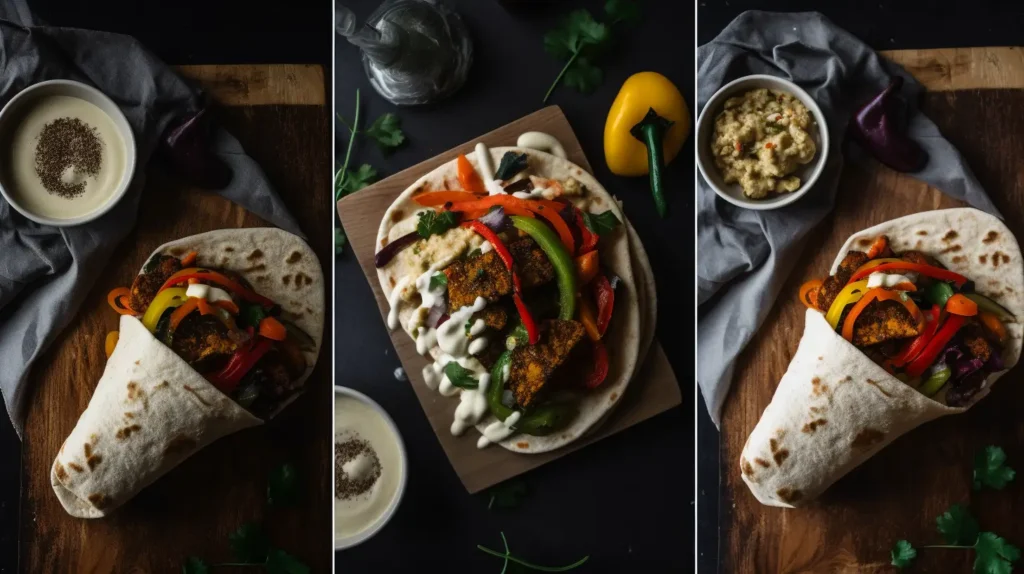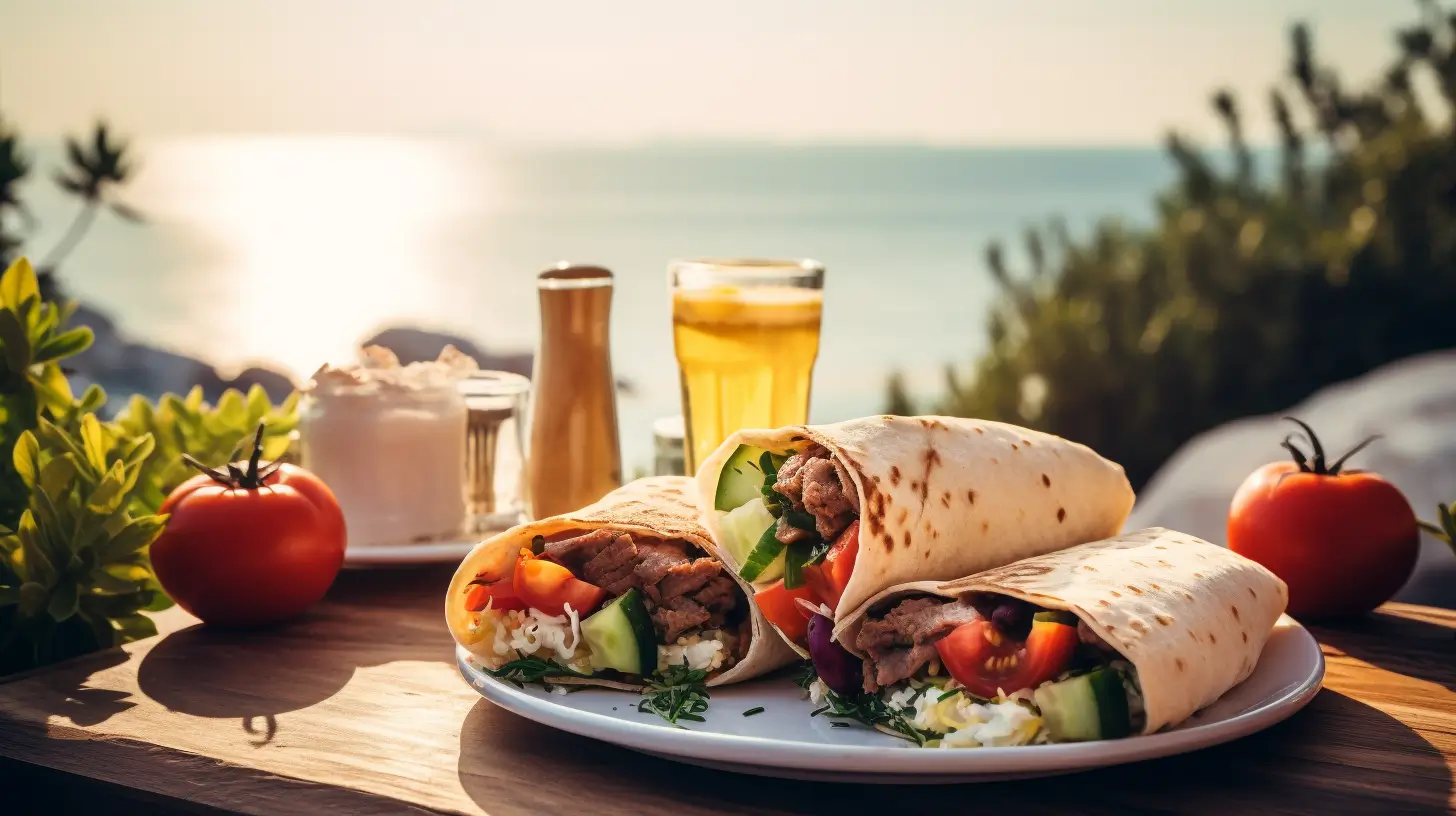Table of Contents
Introduction
Have you ever had one of those lunches that hits all the right notes—delicious, satisfying, and easy to eat on the go? That’s exactly what this Greek-inspired wrap offers. Imagine warm pita bread wrapped around perfectly seasoned meat, fresh veggies, and a creamy tzatziki sauce. It’s a little bit of heaven in your hands, and it’s no wonder these wraps have become a global favorite.
Whether you’re grabbing one from your favorite food truck or looking to make it at home, a gyro wrap is a versatile meal that works for any occasion. In this guide, we’ll dive into what makes this dish so special, how to make it yourself, and the many ways you can customize it to suit your taste. Ready to dig in? Let’s get started!
What Makes This Dish Special?
A Global Favorite with Greek Roots
Gyro wraps trace their origins to Greece, where the word “gyro” means “turn” in Greek. The name refers to the way the meat is cooked—rotating on a vertical spit until it’s perfectly tender and flavorful. Traditionally, gyro meat is made from lamb, beef, or pork, though chicken has also become a popular choice.
What sets this delicious wrap apart is its combination of rich, savory meat with refreshing vegetables and tangy tzatziki sauce. Served in soft pita bread, they’re portable, easy to eat, and packed with flavor. This makes them a perfect choice for lunch, whether you’re on the move or enjoying a relaxed meal at home.
Why You Should Try a Gyro Wrap
- Quick and convenient: Ideal for busy days when you need a satisfying meal fast.
- Balanced and nutritious: Packed with protein, veggies, and carbs, it’s a well-rounded meal.
- Endlessly customizable: Whether you prefer spicy, savory, or even vegetarian options, this dish is endlessly versatile.
The Cultural Significance of Gyro Wraps
While a gyro wrap is undoubtedly a delicious lunch option, its roots go far beyond the plate. In Greece, gyros are more than street food—they’re part of the cultural fabric. They represent community, convenience, and the art of combining simple, high-quality ingredients into something extraordinary. A classic gyro wrap often evokes memories of family gatherings, seaside vacations, or late-night bites with friends after a long day.
As the dish gained global popularity, it adapted to local tastes and preferences while still retaining its essence. For example, in the U.S., you might find gyro wraps stuffed with fries or drizzled with hot sauce for a unique twist. These variations highlight the versatility of the dish, making it a favorite in food trucks, delis, and even upscale restaurants.
Gyro Wraps vs. Similar Wraps
You might wonder how a gyro wrap differs from other popular wraps like shawarma or doner kebab. While all three share similarities in preparation, each wrap has unique distinctions:
- Gyro Wrap: Typically made with Greek-inspired seasonings like oregano and garlic, served with tzatziki sauce in soft pita bread.
- Shawarma: A Middle Eastern variation that often includes tahini or garlic sauce and comes with pickled vegetables for a tangy kick.
- Doner Kebab: A Turkish cousin of the gyro, served with garlic yogurt sauce and often wrapped in lavash or flatbread.
Each of these wraps has its unique flavor profile, but the gyro wrap stands out for its fresh, herbaceous taste and creamy, tangy tzatziki sauce.
How to Make This Greek-Inspired Wrap at Home
Preparing this Greek classic at home might seem daunting, but it’s easier than you think. With a few simple ingredients and a little bit of prep, you can recreate the magic of your favorite Greek restaurant.
Key Ingredients
Here’s what you’ll need for a classic gyro wrap:

| Ingredient | Quantity | Purpose |
|---|---|---|
| Pita bread | 4 pieces | Acts as the wrap base |
| Gyro meat (lamb, beef, or chicken) | 2 cups | Main source of flavor and protein |
| Tzatziki sauce | 1/2 cup | Adds creaminess and tang |
| Sliced tomatoes | 1 cup | Provides freshness and sweetness |
| Sliced cucumbers | 1 cup | Adds crunch and hydration |
| Red onion (thinly sliced) | 1/2 cup | Offers a sharp, savory kick |
| Feta cheese (crumbled) | 1/4 cup | Optional, for a salty touch |
Step-by-Step Instructions
1. Prepare the Meat
If you’re starting with raw meat, season it generously with oregano, garlic, onion powder, and a hint of paprika. Cook it on a skillet, grill, or oven until it’s juicy and slightly crispy around the edges. Thinly slice the cooked meat for easy wrapping.
2. Warm the Pita Bread
To make the pita pliable and flavorful, heat it on a dry skillet for about 30 seconds on each side or wrap it in foil and warm it in the oven.
3. Assemble the Wrap
- Lay a piece of pita bread flat.
- Spread a generous layer of tzatziki sauce over the surface.
- Add a layer of gyro meat in the center.
- Top with sliced tomatoes, cucumbers, red onion, and feta cheese if using.
4. Wrap and Serve
Fold the sides of the pita inward, then roll it up from the bottom to form a snug wrap. If needed, use parchment paper to hold it together while serving.

Creative Variations for Your Favorite Greek Wrap
One of the best things about these wraps is how easy they are to customize. Here are some ideas to make your wrap truly your own:
Vegetarian Gyro Wraps
- Replace the meat with falafel, grilled vegetables, or roasted chickpeas.
- Use hummus or tahini sauce instead of tzatziki for a plant-based twist.
Spicy Gyro Wraps
- Add harissa, sriracha, or chili flakes for a kick of heat.
- Top with pickled jalapeños or spicy yogurt sauce.
Breakfast Gyro Wraps
- Swap the gyro meat for scrambled eggs and breakfast sausage.
- Add avocado slices and a drizzle of hot sauce for a morning boost.
Gluten-Free Gyro Wraps
- Use gluten-free pita bread or wrap the ingredients in a large lettuce leaf for a low-carb option.

Nutritional Benefits of Gyro Wraps
A well-balanced wrap can be a nutritious choice for lunch, especially when made with lean meats and fresh vegetables. Here’s a breakdown of what makes this dish a wholesome option:
- High in Protein: Whether you choose lamb, chicken, or beef, the protein content helps keep you full and energized throughout the day.
- Rich in Healthy Fats: Olive oil in the marinade and tzatziki sauce provides heart-healthy fats.
- Loaded with Vegetables: Ingredients like tomatoes, cucumbers, and onions add fiber, vitamins, and antioxidants.
- Whole-Grain Options: Choosing whole-grain pita can boost the fiber content, aiding digestion and maintaining energy levels.
By customizing your meal with lighter sauces and extra vegetables, you can enjoy a filling, delicious option without overindulging. Learn more about why this diet is so healthy at EatingWell.
Unique Regional Variations of Gyro Wraps
The beauty of a gyro wrap is its adaptability. Around the world, chefs and home cooks have put their spin on this Greek classic. Here are a few noteworthy variations:
- American Gyro Wrap: Often includes crispy French fries inside the wrap for added texture and flavor.
- Middle Eastern-Influenced Gyro Wrap: Features spices like sumac and cardamom in the meat marinade for a bolder, aromatic profile.
- Asian Fusion Gyro Wrap: Combines teriyaki-marinated meat with a sesame-infused tzatziki for a creative blend of flavors.
- Vegetarian Gyro Wrap: Relies on grilled halloumi cheese or roasted eggplant as a flavorful alternative to meat.
Each version demonstrates how the humble gyro wrap can be reimagined to suit different cuisines and palates.
Meal Prep Tips for Greek-Style Wraps
For busy weekdays, prepping your gyro wraps ahead of time can save you both time and stress. Here’s how:
- Batch Cook the Meat: Grill or bake a large portion of seasoned meat, then slice it thin and store it in airtight containers. It will stay fresh in the fridge for up to 3 days or in the freezer for up to a month.
- Pre-Chop Veggies: Slice tomatoes, cucumbers, and onions in advance and store them in separate containers to maintain freshness.
- Make Tzatziki in Advance: Homemade tzatziki can be stored in the fridge for up to 5 days, making it easy to assemble wraps on demand.
- Warm as You Go: Heat the pita bread just before assembling your wrap to keep it soft and pliable.
With these tips, you’ll have everything you need to enjoy a fresh, flavorful meal any day of the week.
What to Serve with Gyro Wraps
Pairing your gyro wrap with the right sides can take your meal to the next level.
Traditional Mediterranean Sides
- Greek Salad: A mix of cucumbers, tomatoes, olives, and feta cheese with a simple olive oil dressing.
- Dolmas: Grape leaves stuffed with rice and herbs for a flavorful appetizer.
- Spanakopita: Flaky phyllo pastry filled with spinach and cheese.
Modern Accompaniments
- Sweet Potato Fries: A crispy, sweet side that balances the savory wrap.
- Quinoa Salad: A light and refreshing option with a Mediterranean twist.
- Roasted Veggies: Seasonal vegetables roasted with olive oil and herbs.
Drinks That Pair Perfectly
- White Wine: A crisp Sauvignon Blanc or Pinot Grigio complements the wrap’s fresh flavors.
- Iced Tea with Lemon: A non-alcoholic option that’s refreshing and easy to make.
- Sparkling Water with Herbs: Infuse water with mint or basil for a sophisticated touch.
Tips for Perfect Gyro Wraps
- Don’t Overfill: Too many ingredients can make the wrap difficult to handle. Stick to moderate portions for balance.
- Use Fresh Ingredients: The fresher your veggies and pita, the better your wrap will taste.
- Experiment with Sauces: Don’t limit yourself to tzatziki. Try garlic aioli, spicy mayo, or tahini for new flavors.
FAQs About Gyro Wraps
What is a gyro wrap made of?
A gyro wrap typically includes pita bread, seasoned meat, tzatziki sauce, fresh vegetables, and optional toppings like feta cheese.
Can I make gyro wraps without meat?
Absolutely! Vegetarian options like falafel or grilled vegetables are delicious alternatives.
How do I keep my gyro wrap fresh for lunch?
Wrap it tightly in parchment paper or foil and store it in a lunchbox with an ice pack to keep it fresh until you’re ready to eat.
What’s the best way to reheat a gyro wrap?
Reheat the meat and pita separately to maintain texture, then reassemble your wrap before serving.
Are gyro wraps healthy?
Yes, they can be a balanced meal when made with lean meats, fresh veggies, and whole-grain pita.
Final Thoughts
These Mediterranean-inspired wraps are more than just a meal—they’re a flavorful journey you can easily bring to your table. Whether you’re enjoying a traditional lamb gyro or experimenting with a vegetarian version, these wraps offer endless possibilities for customization. Whether you stick to the classic version or discover new ideas inspired by recipes like our spicy fajita veggies, there’s no wrong way to enjoy this dish.
So why wait? Try preparing your own version at home and experience the joy of this Mediterranean classic. Share your creations in the comments below—we’d love to see your take on this delicious dish!

